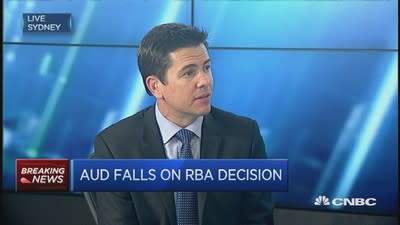Why Aussie will still weaken without rate cuts

The Reserve Bank of Australia (RBA) may have removed its easing bias, but that's not enough to avert a slide in the Aussie dollar (Exchange: AUD=), analysts say.
After initial losses sparked by the RBA's decision to slash rates by 25 basis points to a record low of 2 percent, the Aussie rebounded to gain 1 percent against the U.S.dollar as the central bank painted a fairly upbeat picture of the economy.
"There's no explicit easing bias now, so we that's why had a bounce in the Aussie [Tuesday]. But there are still plenty of negatives for currency moving forward," Sean Callow, senior currency strategist at Westpac Bank (ASX: WBC-AU) told CNBC.
Monetary policy aside, there are overriding headwinds that will continue to put pressure on Aussie, said Callow, who expects the currency to end the year at $0.72, a 9 percent decline from current levels.
A strengthening U.S. dollar (New York Board of Trade (Futures): =USD), sluggish domestic economy and low commodity prices are the three main risks.
"As we move into the second half of the year, we're likely to see better data out of the U.S. and that should support the U.S. dollar and trim the Aussie," said Sean Callow, who expects the Federal Reserve will begin hiking rates in September.
"Also on the commodity front, it's hard to argue that we've turned a corner in terms of prices given the Chinese economy hasn't bottomed yet and the supply of key commodities is ample," added Callow.
Read More Australian equities, Aussie dollar choppy after RBA rate cut
Callow wasn't alone in his bearish outlook for the currency, which has fallen almost 4 percent against the greenback so far this year.
Daniel Been, senior FX strategist at ANZ mirrored his view, prediction the currency will fall to $0.70 by the end of 2015.
"The focus will shift from domestic dynamics to other factors," he said, also citing a strengthening dollar and the underperformance of industrial commodity prices.
Even the RBA, which has made no secret its desire for a weaker Aussie dollar, expects the currency to head further south.
"Further depreciation seems both likely and necessary, particularly given the significant declines in key commodity prices," Stevens said.
In December, Stevens told local media that he would prefer to see the currency at $0.75 - levels not seen since early 2009.
More From CNBC

